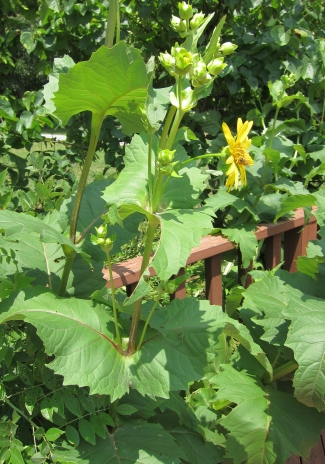A couple of years ago (have we been blogging for that long?!) I wrote a bit on defining our terms – beyond simply native, non-native, invasive. One of my points was that natives can be overly-vigorous, but some people take exception with the term "invasive" when used with native plants. I chose "passive-aggressive" as a way to describe certain mild-mannered natives that end up reseeding rampantly.
One example: Silphium perfoliatum – Cup Plant.

Climbing right out of the garden and onto our deck.
The genus Silphium is comprised of fifteen (+) (at the moment) species, often grouped under the common name "Rosinweed." I’d not paid much attention to the genus until a trip to a bit of tall grass prairie in 2004 got me hooked on these towering lovelies. I’ve grown S. terebinthaceum, S. trifoliatum, and S. laciniatum. All seem much better behaved than S. perfoliatum; but not as fun. The coarse, square stems; perfoliate water-holding leaves, and overall grand scale makes cup plant perfect for back of the border or scattered throughout a meadow planting.
Silphium perfoliatum ranges up through eastern N. America from Louisiana to Quebec and west to Nebraska and Kansas. Big, round buds give way to golden yellow flowers – yet another “yellow daisy thingy” or YDT The YDT designation is a totally non-scientific teaching term for the yellow-flowered Asteraceae clan that grace the mid- and late-summer garden.

Honeybees and butterflies love the ring of oversize, nectar-filled disk florets and bees collect pollen from the stamen. The ray florets are fertile and a flower head can set copious amount of seed. Once ripe, the achene floats away on a breeze (if not scarfed up by a goldfinch)…to land and germinate in some part of your garden not intended for a 9’ tall yellow daisy thingy. Hence the aggressive part. Weed out the unwanted early on, when those first coarse leaves appear; wait too long and the tap root will make it tough to pull. I say this from recent experience (last night) when I upended myself trying to yank some unyielding Silphium from a clump of unsuspecting Echinacea. Ended up chopping the huge stems off at the base -possibly to be used as firewood.
When you mentioned overly vigorous natives and had a picture of Silphium perfoliatum I expected you to mention what I have observed with this species when grown in fertile gardens. They are so vigorous they fall over just about the time they begin to flower. I have never heard of a YD
T. That must be a sanitized version of a DYC (damned yellow composite).
I’ve grown cup plant for a long time. I first put in a perennial bed but once it got to big I dug out, divided and planted in a few plants on our property. I was told that it wouldn’t do well in the very sandy soil but after 10+ yrs the clumps are doing well. It hasn’t spread though beyond the original plants.